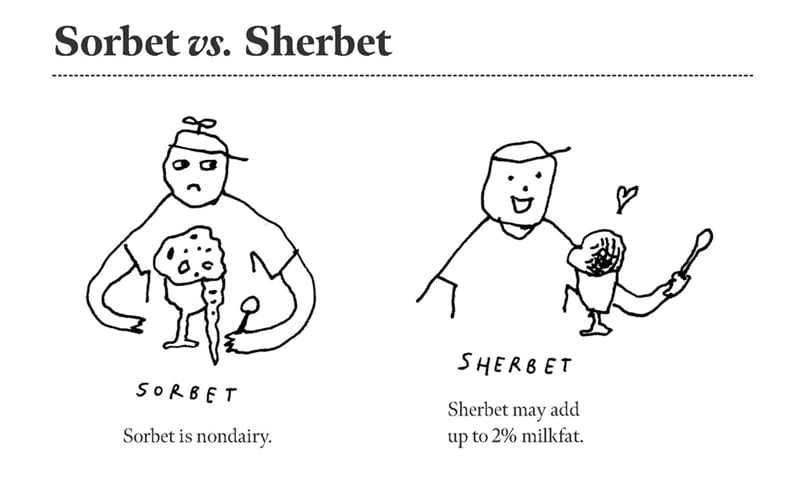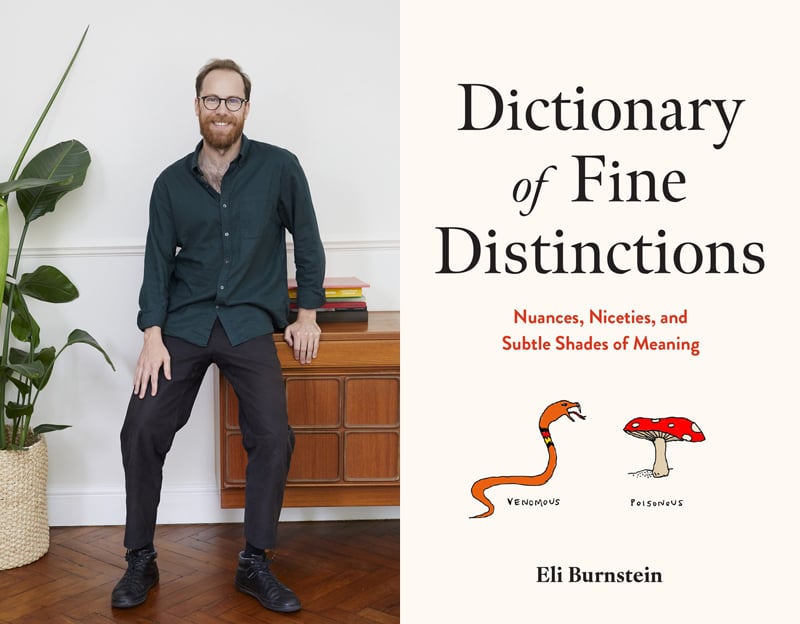To call humour writer Eli Burnstein a dedicated splitter of hairs would be an understatement.
In his forthcoming book, Dictionary of Fine Distinctions: Nuances, Niceties, and Subtle Shades of Meaning (Union Square & Co., April 9) Burnstein takes a fine-toothed comb to 107 groups of words and concepts to determine the discrete differences between them. The ideas he compares range from the conceptual (i.e. natural numbers vs. integers vs. rational numbers vs. real numbers) to the literary (i.e. epigram vs. aphorism vs. maxim vs. adage vs. proverb) to the material (i.e. sorbet vs. sherbet), and range in topic from the consumable to the political and nearly everything in between.
The project was born out of Burnstein’s inability to parse the minute differences between certain pairs of colours. His partner used to mock him for not being able to tell the difference between maroon and burgundy or teal and turquoise.
“I thought, to spare myself future embarrassment, I would make a study of it,” Burnstein told Q&Q recently from his home in London, U.K. “Pretty quickly I discovered colours were just the tip of the iceberg in terms of phenomena that I commonly mix up, or that I don’t know there’s a difference between because they are so subtle.”
To create the book, Burnstein, whose work has appeared in The New Yorker and McSweeney’s Internet Tendency, started making a list of such terms. The list was informed by his own interests – readers will note a decided lack of comparisons between similar animals, for example – but Burnstein was committed to eclecticism in order to capture a broad spectrum of experience.
“The goal was less for us to know about specific aspects of life or to go deep in any one area than to canvas the whole array of subtlety in life, to really convey a sense that nuance is all around us, whether in the way we talk about irony and sarcasm or the way we talk about natural landscapes or emojis or feelings,” he says.
To determine the differences between terms, Burnstein had a systematic research process. First, consult a dictionary. He consulted three: Merriam-Webster online, the Oxford Dictionary of English, and the Oxford English Dictionary, to compare definitions. Next up were usage manuals – Garner’s Modern English Usage and all four editions of Fowler’s Modern English Usage (the precise name of which varies between editions). Burnstein would turn to encyclopedias for differences that were more material, and consulted subject-matter experts for a number of comparisons, including lawyers (for the differences between common law and civil law), the dean of a music school (for the differences between 4/4 time and 2/2 time), and baristas (to set out the definitive differences between a latte, a flat white, a cortado, and a cappuccino).

Excerpted with permission from Dictionary of Fine Distinctions by Eli Burnstein © 2024. Published by Union Square & Co. Illustrations by Liana Finck.
He pitched the book as an illustrated title, and when looking for someone to illustrate his work, thought of Liana Finck, a Brooklyn-based cartoonist who is a regular contributor to The New Yorker.
“You know, what I’m doing is awfully neurotic, and has this analytical squiggly energy already,” Burnstein says. “I think that she really brings that out.”
The black-and-white illustrations sit between paragraphs of text, and the entry for each comparison varies in length depending on the complexity of the distinction. The differences between an emoji, an emoticon, and a kaomoji, for example, are covered in one page with three illustrations, while other distinctions are distilled over as many as three pages, sometimes with no illustrations at all, as with the two-page entry for the differences between jargon and slang.
Burnstein, who continues to keep a running list of further terms for comparison, hopes readers of the book will gain an appreciation for the subtlety that exists all around us.
“It’s amazing what the human mind has done and what we have done with language in being able to track all these minute differences,” he says. “When I say ‘I presume,’ rather than ‘I assume,’ whether or not we’re conscious of it, we are telling the listener that we are doing something slightly different. It’s amazing that we don’t even need to be conscious of it.”

 Contact us via email
Contact us via email

